Question #4
0 Gross receipts of six movies First Title Weekend Movie A 90.149 Movie B 88.293 Movie C 93.754 Movie D 102.297 Movie E 77.113 Movie F 77.566 National Gross 317.694 261.105 249.062 290.457 292.042 301.179 Worldwide % Gross 976.291 878.921 795.086 896.645 938.179 934.748 Print Done Movie companies need to predict the gross receipts of individual movies alter a movie has debuted. The accompanying results are the rst weekend gross, the national gross, and the worldwide gross (in millions of dollars) of six movies. Complete pans (a) through (d) below. Click the icon to view the gross receipts of the six movies. Find the covariance between rst weekend gross and national gross. (Round to four decimal places as needed.) Find the covariance between rst weekend gross and worldwide gross. (Round to four decimal places as needed.) Find the covariance between national gross and worldwide gross, (Round to four decimal places as needed.) b. Compute the coefficient of correlation between first weekend gross and national gross, first weekend gross and worldwide gross, and national gross and worldwide gross. Find the coefficient of correlation between first weekend gross and national gross. (Round to three decimal places as needed.) Find the coefficient of correlation between first weekend gross and worldwide gross. (Round to three decimal places as needed.) Find the coefficient of correlation between national gross and worldwide gross. (Round to three decimal places as needed.)c. Which is more valuable in expressing the relationship between first weekend gross, national gross, and wordwide gross, the covariance or the coefficient of correlation? Explain. O A. The coefficient of correlation, because it measures the relative strength of a linear relationship between each pair of variables. O B. The covariance, because it measures the relative strength of a linear relationship between each pair of variables. O C. The covariance, because it reflects the differences between each pair of variables. O D. The coefficient of correlation, because it can prove that there is a causation effect between each pair of variables










